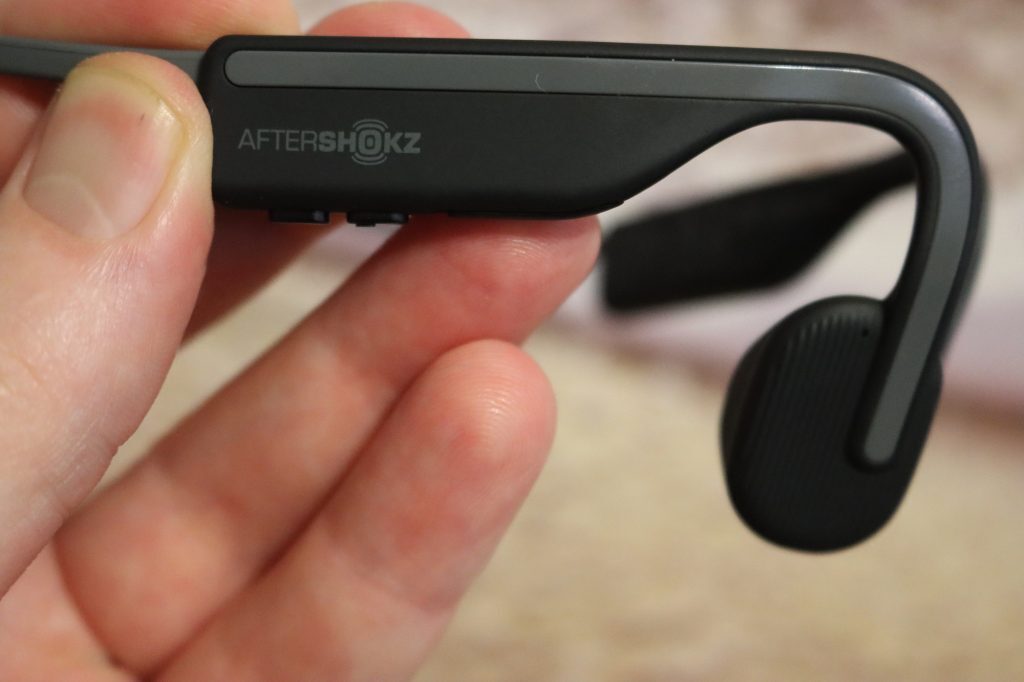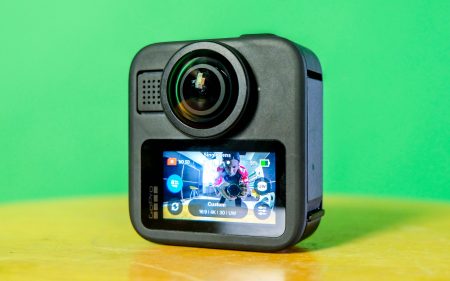-
Design
-
Audo quality
-
Battery
-
Features
The team here at Stuff are a little obsessive about headphones — some more than others, but everyone’s got a taste for a good set of head-mounted audio enhancers. Whether it’s in, on or over-ears, we’re there. Aftershokz’ OpenMove headphones are a little unusual — wireless bone conduction headphones. Believe it or not, we don’t often see these passing through Stuff‘s doors.
It’s not through lack of trying. They just don’t turn up all that often. The companies that make them aren’t quite as prolific as the likes of Jabra, Sennheiser, Sony, Samsung or even Apple. Aftershokz’ OpenMove wireless headphones were a strange experience for us, then. We’re used to more contact, and also to more immersive sound. But that’s not an option for everybody, either for medical or comfort reasons. Why not try something different?
Walking the wire
 At first glance these fitness-focussed wireless ‘phones are, indeed, something different. They use a very different transmission method to traditional headphones, going through your cheekbones rather than down your ear canal and to your eardrums. As such, there’s no speaker — just a pair of transducers designed to rest on your cheeks or temples.
At first glance these fitness-focussed wireless ‘phones are, indeed, something different. They use a very different transmission method to traditional headphones, going through your cheekbones rather than down your ear canal and to your eardrums. As such, there’s no speaker — just a pair of transducers designed to rest on your cheeks or temples.
In terms of design, the OpenMove looks like something from Cyberpunk 2077‘s player inventory. There’s a firm, flexible wire connecting the two working parts. These parts are substantial, soft-textured plastic that terminate in the two transducers. Along the bottom of the right section is a concealed USB-C charge port, directly next to the volume/power buttons. On the left-hand transducer, hidden by a second of the metal band, is a single Play/Pause button that also performs other functions if you get tap-happy with it.
The transducers are magnetic. We’re not exactly sure why, unless it’s to keep them together around your neck while you’re at the gym, because they don’t appear to turn off or disconnect the ‘phones when the magnetic tips are in contact. You’ve got to do that manually. Oh well, at least they stick to the fridge.
Fit for purpose
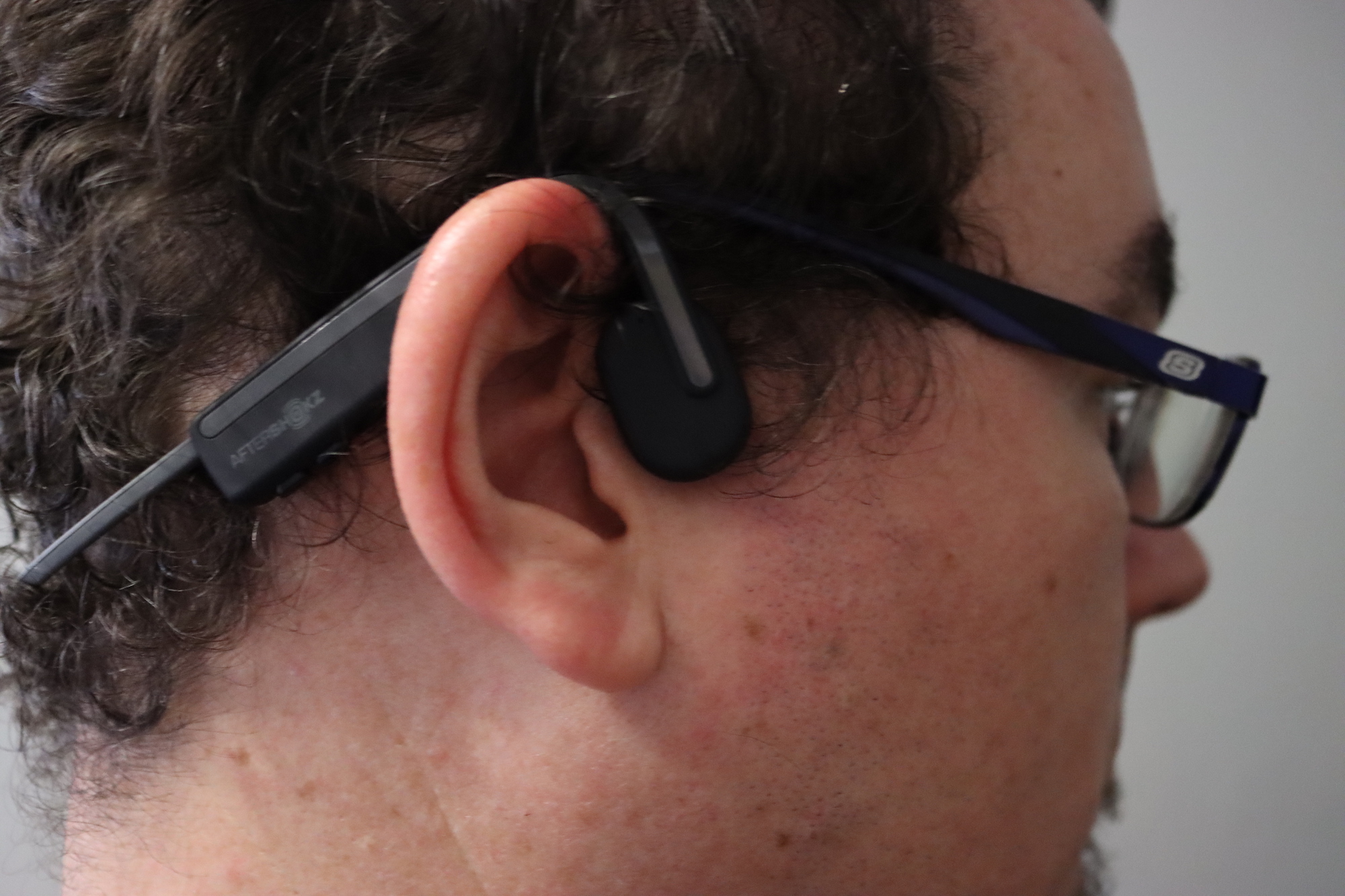 The OpenMove headphones are not massive, and the connecting wire is firm enough that you’ll notice you’re wearing them, but comfort shouldn’t be an issue. Unless you have an unusually small (or large) head, that is. Aftershokz have gone for a ‘one size fits all’ approach and there’s no way to adjust fit for comfort — which is a pity. Put them on right, however, and you’ll need an impact to the side of your head to shift them.
The OpenMove headphones are not massive, and the connecting wire is firm enough that you’ll notice you’re wearing them, but comfort shouldn’t be an issue. Unless you have an unusually small (or large) head, that is. Aftershokz have gone for a ‘one size fits all’ approach and there’s no way to adjust fit for comfort — which is a pity. Put them on right, however, and you’ll need an impact to the side of your head to shift them.
Most won’t have any problems wearing the OpenMoves for several hours — up to six at a time, before you have to head to the charger. We found that they run out a little sooner than six hours but we were also blasting Dave Mustaine’s grating voice on every Megadeth album ever released for this review. Yes, even (bits of) Super Collider. Higher volume equals slightly lower battery, and you don’t need high volumes. You just want ’em.
In addition to decent battery and a speedy charge time, these are also rated IP55. You shouldn’t kill ’em during your workout, unless you drop a kettlebell on them.
Placement for these headphones is a weird one. It’s a little further forward on your head than you’re expecting. It’s possible to position them over your tragus (the flappy bit at the front of your ear) and then you’re more or less listening in the usual manner. But then they’re prone to shifting and the audio gets a little hinky, because you’re transmitting through flesh instead of bone. A bit further forward and you’ll experience your tunes as weird… for a few minutes. After that, you get used to the vibration and wonder why you ever thought bone conduction was strange.
Listen here you little —
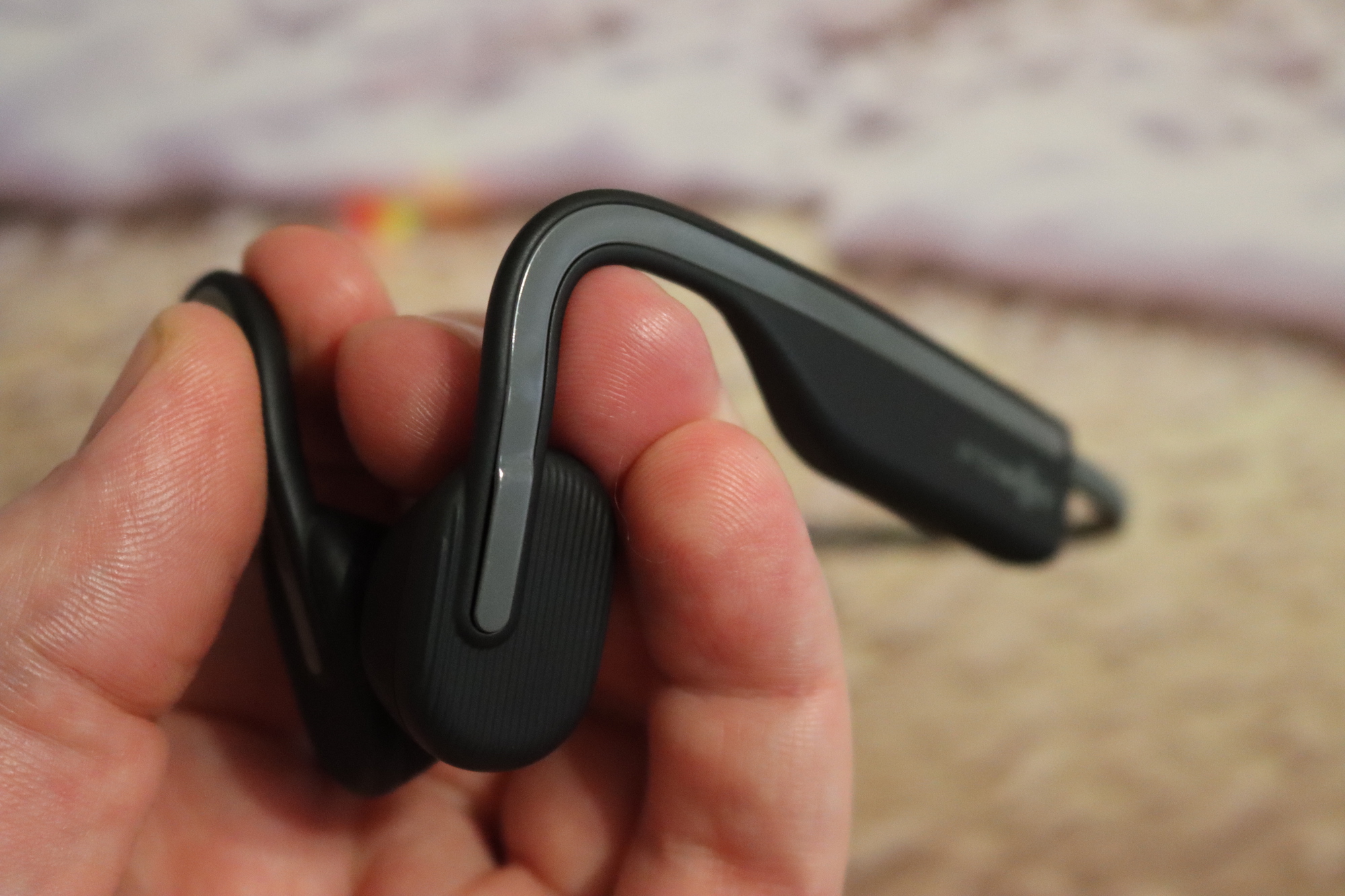 And that’s because the audio from these is pleasantly — even surprisingly — good. The company touts it PremiumPitch 2.0 tech, which admittedly works. Though your ears are never blocked, you’ll wind up with clear audio playing in the middle of your head. It takes a bit of concentration to realise that you’re not really hearing the usual way but sound reproduction is detailed enough that you won’t care.
And that’s because the audio from these is pleasantly — even surprisingly — good. The company touts it PremiumPitch 2.0 tech, which admittedly works. Though your ears are never blocked, you’ll wind up with clear audio playing in the middle of your head. It takes a bit of concentration to realise that you’re not really hearing the usual way but sound reproduction is detailed enough that you won’t care.
But audio quality isn’t perfect. That’s a given with an open design like this. Your eardrums are still exposed and you can still hear normally — that’s going to interfere with your listening experience unless you’re listening to tunes on these while in an isolation tank. But you don’t strike us as the Joe Rogan, DMT-taking types so we’ll assume you’re somewhere you can hear traffic or voices. Also, it’s hard to get decent bass going when you’re transmitting through bone. Not impossible. But difficult.
The audio experience is ideal for a gym or a bout of pounding the pavement. There’s a spot of sound leakage but you’ll need to be well within the recommended social distance in order to notice it. Your workout playlists will likely remain a secret, unless you’re head-butting other gym-goers. That’s always a bad idea, if sometimes unavoidable in Fourways.
Aftershokz OpenMove Verdict
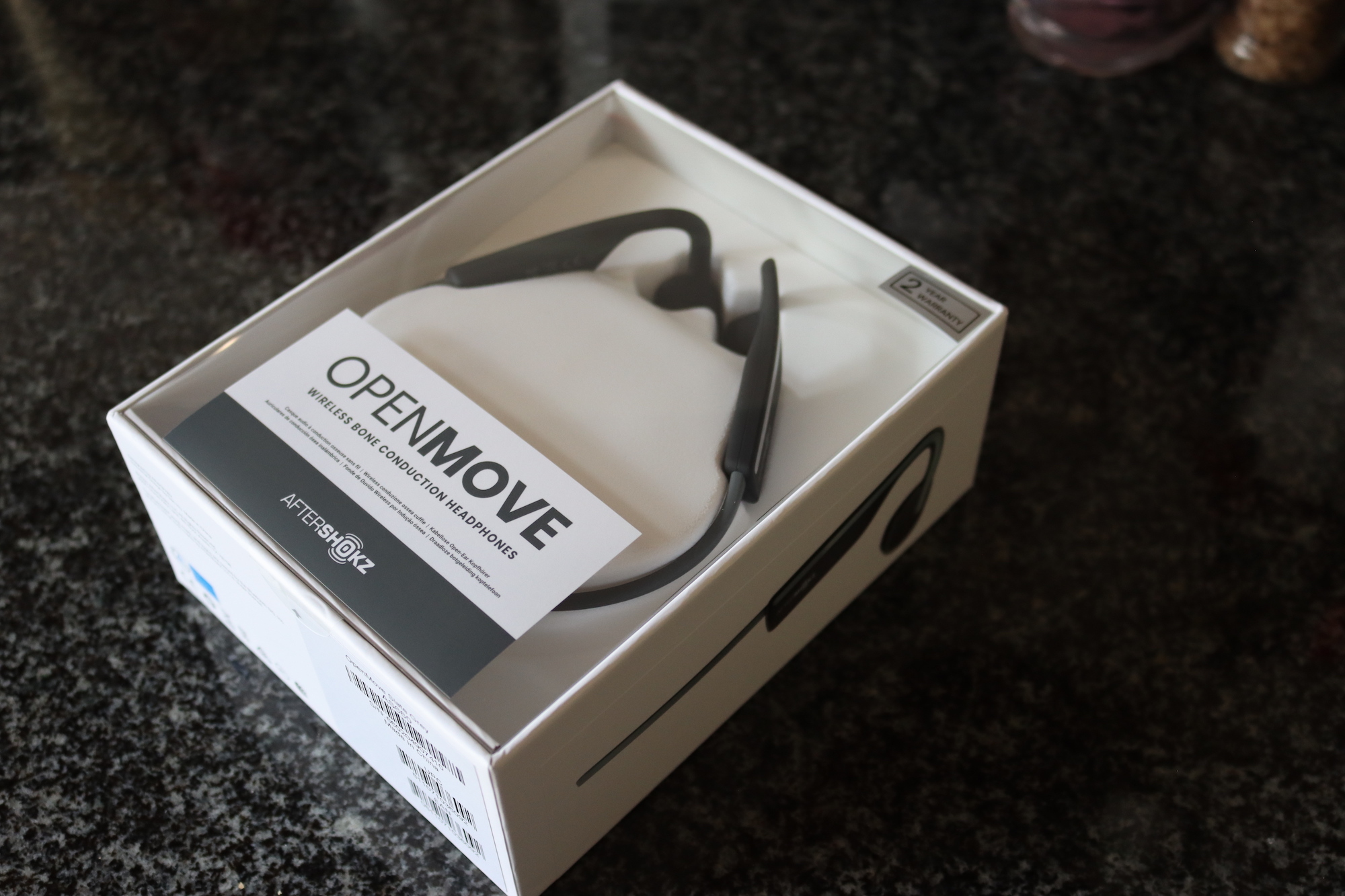 If you’re after the very best audio experience, you’d be best served looking elsewhere. And it’d help to reassess your workout priorities. The audio here is more than decent but the delivery method isn’t great for picking out nuances from your favourite Limp Bizkit tracks (they’re in there somewhere, possibly). It’s better than you’re expecting but you’re not in for that whole audiophile immersion experience.
If you’re after the very best audio experience, you’d be best served looking elsewhere. And it’d help to reassess your workout priorities. The audio here is more than decent but the delivery method isn’t great for picking out nuances from your favourite Limp Bizkit tracks (they’re in there somewhere, possibly). It’s better than you’re expecting but you’re not in for that whole audiophile immersion experience.
More likely, you’re after great workout kit without the icky feeling that comes from sweating around a set of in-ears for 45 minutes. In that case, you’ve found what you’ve been looking for. Best of all, these also work if you’ve got eardrum issues. Provided your cochlear is er… clear, Aftershokz’ OpenMove should work for you just fine.

